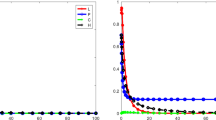Abstract
The interactions of host plants with herbivores can be mediated by factors other than population sizes or biomass alone. Recent evidence indicates that features of the vegetation (loosely termed “plant quality”) may change in response to herbivory and may, in turn, influence the performance of herbivores (i.e. by affecting survivorship, fecundity, or growth rates). A model which incorporates the effect of plant quality is presented. First it is shown that the frequency distribution of plant quality in the vegetation (p(q, t)) satisfies an equation of conservation. Then, qualitative aspects of the system are discussed in three situations: (1) mobile herbivores interacting with all plants; (2) sessile herbivores feeding exclusively on single plants; (3) intermediate situations in which mobility is moderate to low.
I show that depending on the plant quality response, f(q, h), and the herbivore response, g(q, h), it is possible to obtain stable equilibria as well as stable periodic oscillations. In the former case the populations tend to lose their heterogeneity. In the latter case, oscillations are accompanied by alternate narrowing and broadening of the distribution. Empirical testing and further research are suggested.
Similar content being viewed by others
References
Cain, M. L. (1985), Random search by herbivorous insects: a simulation model. Ecology, 66(3), 876–888.
Caughley, G., Lawton, J. H. (1981) Plant herbivore systems. In: Theoretical Ecology. May, R. M. (ed.) 2nd edn. Sinauer Associates, Sunderland, pp. 132–166
Crawley, M. J. (1983) Herbivory: the dynamics of animal-plant interactions. Studies in Ecology 10. University of California Press, Berkeley
Denno, R. F., McLure, M. S. (eds.) (1983) Variable plants and herbivores in natural and managed systems. Academic Press, NewYork
Dyer, M. I. (1975) The effects of red-winged blackbirds (Agelaius phoeniceus, L) on biomass production of corn grain (Zea Mays, L). J. Appl. Ecol. 12, 719–726
Edelstein, L., Hadar, Y. (1983) A model for size distributions in submerged mycelial cultures. J. Theor. Biol. 105, 427–452
Edmunds, G. F., Alstad, D. N. (1978) Coevolution in insect herbivores and conifers. Science 199, 940–945
Fischlin, A., Baltensweiler, W. (1979) Systems analysis of the larch bud moth system. Part 1: the larch-larch bud moth relationship. In: Delucchi, V., Baltensweiler, W. (eds.) Dispersal of forest insects. IUFRO, Zuoz, Switzerland, pp. 273–289
Ghent, A. W. (1960) A study of group-feeding behavior of larvae of the jack pine sawfly Neodiprion pratti banksianae, Roh. Behavior 16, 110–148
Haukioja, E. (1981) On the role of plant defenses in the fluctuation of herbivore populations. Oikos 35, 202–213
Karlin, S., Taylor (1981) A second course in stochastic processes. Academic Press, New York
Kareiva, P. (1982) Experimental and mathematical analyses of herbivore movement: quantifying the influence of plant spacing and quality on foraging discrimination. Ecological Monographs 52, 261–282
Kraft, S. K., Denno, R. F. (1982) Feeding responses of adapted and non-adapted insects to the defensive properties of Baccharis halimifolia L. (Compositae). Oecologia 52, 156–163
Lapidus, L., Pinder, G. F. (1982) Numerical solution of partial differential equations in science and engineering. Wiley, New York
Lincoln, D. E., Newton, T. S., Ehrlich, P. R., Williams, K. S. (1982) Coevolution of the checkerspot butterfly Euphydryas chalcedona and its larval food plant Diplacus aurantiacus: larval response to protein and leaf resin. Oecologica 52, 216–223
Ludwig, D, Jones, D. D., Holling, C. S. (1978) Qualitative analysis of insect outbreak systems. The spruce budworm and forest. J. Animal Ecol. 46, 315–332.
Mattson, W. J., Addy, N. D. (1975) Phytophagus insects as regulators of forest primary production. Science 190, 515–522
May, R. M., Conway, G. R., Hassell, M. P., Southwood, T. R. E. (1974) Time delays, density dependence, and single-species oscillations. J. Animal Ecol. 43, 747–770
May, R. M. (1973) Stability and complexity in model ecosystems. Princeton University Press, New Jersey
McNaughton, S. J. (1983) Compensatory plant growth as a response to herbivory. Oikos 40, 329–336
Moran, N., Hamilton, W. D. (1980) Low nutritive quality as a defense against herbivores. J. Theoret. Biol. 86, 247–254
Myers, J. H., Post, B. J. (1981) Plant nitrogen and fluctuations of insect populations: a test with the Cinnabar Moth-Tansy Ragwort System. Oecologia 48, 151–156
Okubo, A. (1980) Diffusion and ecological problems: mathematical models. Springer, Berlin, Heidelberg, New York
Parker, M. A., Root, R. B. (1981) Insect herbivores limit habitat distribution of a native composite, Machaeranthera canescens. Ecology 62, 1390–1392
Patlak, C. S. (1953) Random walk with persistence and external bias. Bull. Math. Biophys. 15, pp. 311–338
Pimentel, D. (1976) World food crisis: energy and pests. Bulletin of the Entomological Society of America 22, 20–26
Rhoades, D. F. (1982) Herbivore population dynamics and plant chemistry. In: Variable plants and herbivores in natural and managed systems. Denno, R., McLure, M. (eds.). Academic Press, New York
Rubinow, S. I. (1968) A maturity-time representation for cell populations. Biophysical Journal 8, 1055–1073
Segel, L. A. (1980) The general balance law and the diffusion equation. In: Segel, L. A. (ed.). Mathematical models in molecular and cellular biology. Cambridge University Press, Cambridge, pp. 440–452
Strong, B. R., Lawton, J. H., Southwood, R. (1984) Insects on plants: community, patterns, mechanisms. Harvard University Press, Cambridge, MA
Thompson, R. W. (1982) Comments on size dispersion in living systems. J. Theor. Biol. 96, 87–94
Von Foerster (1959) In: Stohlman, F. (ed). The kinetics of cellular proliferation. Grune and Stratton, New York, pp. 382–407
Wang, Y., Gutierrez, A. P., Oster, G., Daxl, R. (1977) A population model for plant growth and development: coupling cotton-herbivore interaction. Canadian Entomologist 109, 1359–1374
Whitham, T. G. (1980) The theory of habitat selection: examined and extended using Pemphigus aphids. American Naturalist 115, 449–466
Whitham, T. G., Williams, A. G., Robinson, A. M. (1984) The variational principle: individual plants as temporal and spatial mosaics of resistence to rapidly evolving pests. In: Price, P. W., Slobodchikoff, C. N., Gaud, W. S. (eds.). A new ecology: novel approaches to interactive systems. Wiley, New York
Author information
Authors and Affiliations
Rights and permissions
About this article
Cite this article
Edelstein-Keshet, L. Mathematical theory for plant—herbivore systems. J. Math. Biology 24, 25–58 (1986). https://doi.org/10.1007/BF00275719
Received:
Revised:
Issue Date:
DOI: https://doi.org/10.1007/BF00275719




